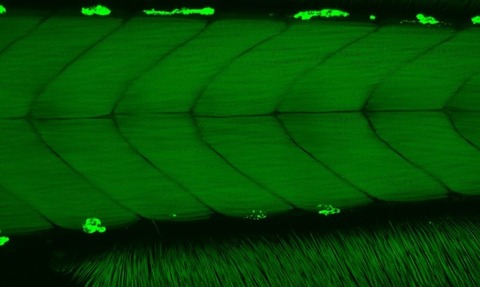
Olympus has introduced its latest high-speed, high-precision deep-imaging multiphoton system FVMPE-RS.
Incorporating several innovative features, the latest addition to the Olympus FluoView range of confocal laser scanning microscopes is designed to present new possibilities in deep, in vivo imaging.
Multiphoton excitation microscopy combines laser scanning microscopy with multiphoton fluorescence to create high-resolution, three-dimensional images.
The technique can be used to probe deep within living tissues without damaging the sample, presenting a powerful tool within life science research; achieving vital insights into the intricate and complex workings of biological systems, in vivo.
Dedicated to multiphoton microscopy, the FluoView FVMPE-RS from Olympus delivers rapid and accurate performance, enabling sharp image acquisition and measurement deep within the sample.
The Olympus FVMPE-RS is ideal for a host of advanced imaging applications, from multicolour in vivo imaging to combined optogenetics - a technique using light to selectively activate ion channels in living specimens - and electrophysiology studies.
Meanwhile, its flexible and modular design also offers adaptability for researchers designing their own custom-built systems.
The Olympus FVMPE-RS achieves exact timing of multiple imaging and stimulation protocols, as well as extended and complex time-lapse experiments.
Capturing dynamic processes with unmatched speed
With the ability to capture 438 fps at an image size of 512x32 px and at field number 18, the FVMPE-RS boasts one of the fastest frame rates on the market in combination with an extensive Field of View.
Researchers can now track the most rapid processes taking place within the cell, tissue or organism - from the transport of mitochondria through neurones to blood flow analysis and Ca2+ signalling - in real time.
Similarly, observing larger areas is critical for many of these functional imaging studies, and the system also captures full-frame, 512x512 px images at 30 fps without compromising the Field of View.
This is made possible by the hybrid scanning unit, which builds on the capabilities of the high-speed resonant scanner.
A galvanometric scanner is also available for maximising the signal to noise ratio during deep imaging.
An additional galvanometric scanner module is also available for simultaneous 3D stimulation and image acquisition in the sample.
Synchronising excitation and imaging with this SIM Scanner setup is ideal for quantitative photomanipulation experiments and also enables advanced optogenetics studies.
This neuromodulation technique controls and monitors neuronal activity using light sensitive proteins channelrhodopsin and halorhodopsin, and with the FVMPERS, laser light stimulation of these optogenetic “switches” is achieved alongside simultaneous real-time imaging of neuronal cell activity.
Precise multicolour excitation and imaging
Providing further insights into cell connectivity and how different cellular structures interact, the FVMPE-RS is optimised for tracking multiple molecular species simultaneously.
Through multi-wavelength excitation, crosstalk is minimised to produce a clearer definition between multiple fluorophores.
Moreover, with the new system, Olympus has introduced the industry-first four-axis auto-alignment system for precise alignment of multiple laser beams, eliminating pixel shifts caused by excitation beam angle mismatches.
Optimised light path enhances deep-tissue observation
From dedicated multiphoton objectives to a high-sensitivity GaAsP detector, optical efficiency is prioritised at every point of the FVMPE-RS’ light path, achieving bright, high-resolution images deep within the sample.
Allowing the use of low laser power protects living cells against phototoxicity, and precisely adapting the laser to match demanding sample conditions is also realised in “Deep Focus Mode”, which is ideal for in vivo samples with heavy scattering.
Enabling label-free imaging with an extended IR range
Expanding the IR range to accommodate a wider range of fluorophores, the FVMPE-RS now offers optimal multiphoton excitation up to 1300 nm, with the ability to support wavelengths of 1600 nm.
These longer wavelengths are also well-suited to studies utilising third- and second-harmonic generation techniques.
Such label-free imaging allows researchers to visualise structures such as collagen and haemoglobin in their natural state.






